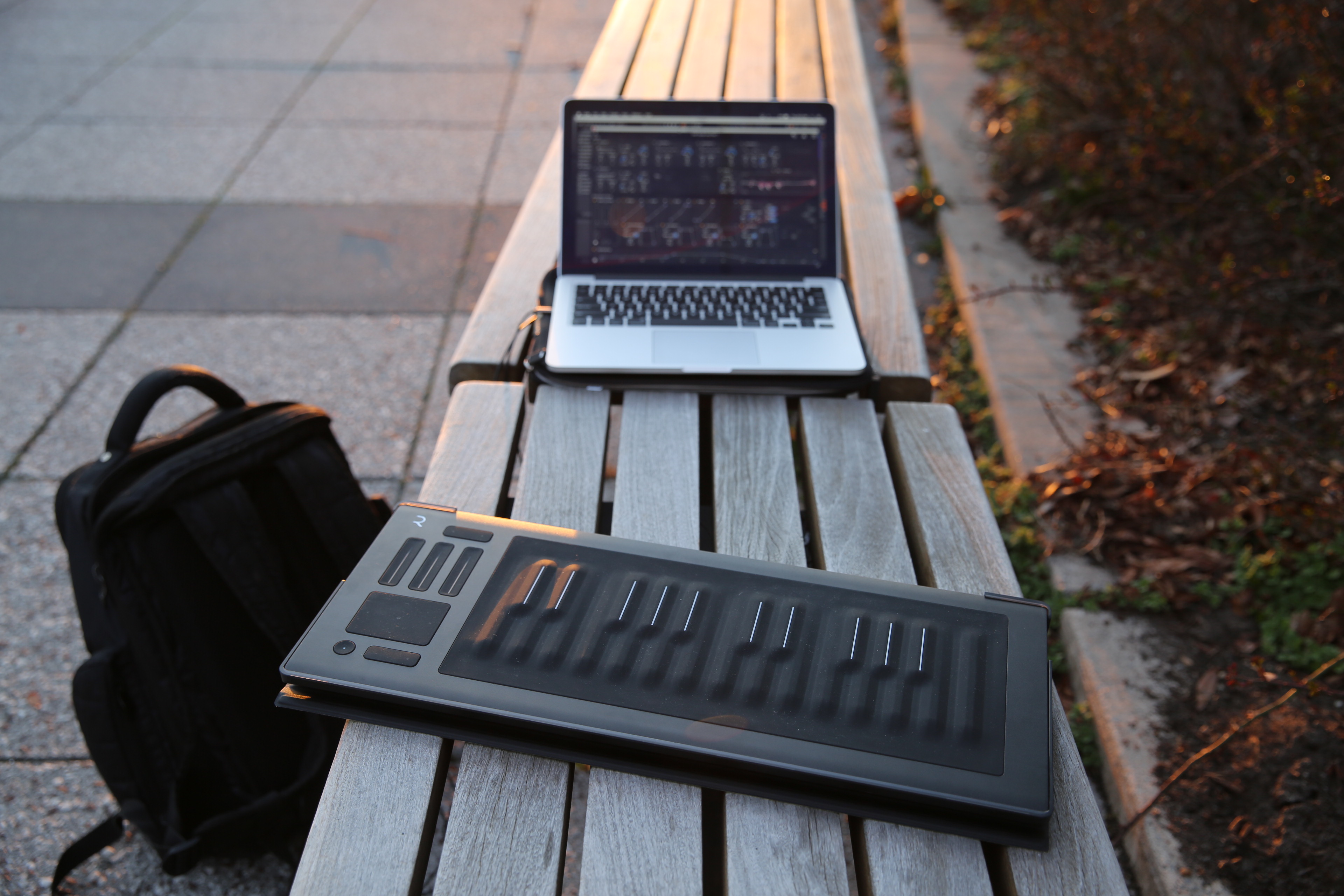On the RISE: Music is life with Stoni
New York-based producer and DJ

“There’s no stage in your life that doesn’t have a song you can reference,” says Stoni, the New York-based producer and DJ known for her hard-driving hip-hop beats. “Like when you graduate from high school, you’re listening to something, and every time you hear that song later you think ‘Ahhh!’ And you get to recapture that feeling, and it makes you feel great.”
Almost every day in Stoni’s life is marked by a particular song, track, or beat – by music that she creates with her ensemble of controllers, groove boxes, and software programs. “Making beats” for her is as constant as it is natural. It’s her way of expressing herself – of channeling the mood she’s in that afternoon. Her newest tool is the Seaboard RISE 25. She has gotten in the habit of taking her RISE to a park bench at New York’s Christopher Street Pier where she sits, cross-legged, and explores sounds with headphones on and head nodding.
“Music has always been a part of my life. I do everything with music. I take my shower with music. I make love with music. I think with music playing in the background. Music makes me feel. Music reminds me of my childhood. Music reminds me of life. It’s healing, and the reason is that it’s coming from somewhere. These tools” – she says, pointing at the Seaboard RISE – “are just conduits for getting those feelings out.”

Her music education started at home in Brooklyn, where she grew up with six brothers and sisters. “My father was Haitian, and he’s one of those fathers who wanted to be Americanized. So he had all these records. He used to play them every Sunday morning: Sam Cooke, Otis Redding, all this old soul music. My brothers and sisters would be out, but I would always be around the house, and he would say: ‘You. Sit down here and listen to this.’ I thought, ‘I don’t want to be here!’ And it wasn’t until much later on, when I was older, that I thought, ‘Whoa! So this is what he was trying to tell me.’”
Stoni became an electronic music producer only after spending years as a engineer in recording studios. The transition is about as unusual as a theater technician becoming a stage actor.
“I can wire a studio from start to finish – like I can literally do that for you right now, if you give me the cables. I thought I wanted to be a recording engineer, and being in the recording studio is where I got my chops. I learned how to patch cables, about automation, about signal flow. The environment of the studio gives you everything you need to know as a music producer as far as the gear: what these different tools are and why they’re there.”
“And when you’re a studio assistant, you also have time on your hands. You’re watching and learning, listening and learning, and I was fortunate to be around a lot of people who were masters of their craft. That’s when I started sampling. I started really listening to music, and I started arranging. And my goals shifted. I liked engineering, but I also liked making beats. It was a natural thing. I didn’t go to school for it, but I was good at it.”
“Music has always been a part of my life. I do everything with music. I take my shower with music. I make love with music. Music makes me feel. Music reminds me of my childhood. Music reminds me of life.“

Stoni’s break came in 2003, when a friend encouraged her to sign up for an international beat battle. She won, making hip-hop headlines as a female producer who seemingly came out nowhere to beat better-known artists.
Since then Stoni has DJ’d around the world and worked with A-list producers, training them how to use cutting-edge music-making equipment. But she has never released an EP – until now. “The Next Level” will come out in May. It will be the first compilation of her trademark sound.
What is that sound? “The beat is hip hop, but the music is really different. It’s ‘world.’ It’s global. It comes from the kind of music I listen to, which could be French music – music from anywhere. My sound is very beats-driven. It’s aggressive, it’s hard-core, it’s edgy. But it has elements of soft and lyrical as well. It’s hard-driving beats, but it’s feel-good music. It’s music people want to dance to.”
As an artist and an engineer, Stoni has made a point of being at the forefront of music technology, and “the Seaboard RISE has my attention right now,” she says.
“What I like most about it is the expression. It’s like nothing else I’ve worked with. When I’m making beats with the RISE, the cool thing is that I can take a sound and manipulate it with my hands instead of knobs.“
“What I like most about it is the expression. It’s like nothing else I’ve worked with. When I’m making beats with the RISE, the cool thing is that I can take a sound and manipulate it with my hands instead of knobs. I use one patch, and with the 5D expression it never sounds the same twice. There’s really endless possibilities in terms of taking sounds and resampling them and shaping them into something completely different from what they were intended to do.”
Stoni’s sampling technique integrates the Seaboard RISE with Native Instruments’ Maschine Studio and Ableton’s Push 2 controller.
“With sampling, I’ll go through the patches inside the RISE – inside Equator – and listen to their different nuances. I pretty much pick whatever speaks to me as I touch it. A sound will speak back to me and I’ll say, ‘Yeah, that’s it! Right there!’ I pick my sounds based on what they make me feel. Then I sample those Equator sounds in my groove box. I take the sound and chop it up, or reverse it, and add different elements – like drum sounds and kicks and snares. That’s how I start building my track, using the groove box to help write the main idea. Then I bring that main idea into a DAW. And then I’ll open up another track with Equator and I’ll embellish the sounds and melodies.”
Stoni does not have one way of using the RISE – or any music-making tool. “The way I use it really depends on the track and how I’m feeling that day.” But she does expect one thing from all of her new gear. “Any new piece I bring into my workflow needs to do multiple things. It needs to have more than one purpose.” For the RISE, that versatility is summed up in how many places she takes it with her.
“I can take a RISE on stage and use it in a live set. I can bring it into my recording studio. I can take it with me to Starbucks. I can take it to the pier.” She laughs describing what happens when she sets up her RISE on her favorite park bench overlooking the Hudson. “People are like: ‘What is that? Can I touch it?’”

The place of these tools in her workflow is evolving, and her sound is evolving with it.
“My sound is changing. The way that I shape my sounds is changing. The whole way I approach production is changing tremendously. I came from a place of pattern sequencing and drum machines. Now we have these new controllers and new tools that let me work more fluidly, and it means I can take my work to new places.”
When “The Next Level” releases in May, discerning producers will greet it as a long-awaited EP of an under-the-radar artist. And even as music lovers discover her sound for the first time, Stoni will be tweaking that sound to suit whatever they love most about the record. Because for her, music is only relevant as long as it “makes people feel.”
“These tools are fantastic. But if you don’t make music where they can feel it, you lose them. If you don’t make them feel, there’s nothing there.”
Follow Stoni on her website and on Twitter.
Join the ROLI community